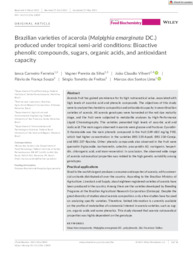Brazilian varieties of acerola (Malpighia emarginata DC.) produced under tropical semi- arid conditions: Bioactive phenolic compounds, sugars, organic acids, and antioxidant capacity.
Brazilian varieties of acerola (Malpighia emarginata DC.) produced under tropical semi- arid conditions: Bioactive phenolic compounds, sugars, organic acids, and antioxidant capacity.
Author(s): FERREIRA, I. C.; SILVA, V. P. da; VILVERT, J. C.; SOUZA, F. de F.; FREITAS, S. T. de; LIMA, M. dos S.
Summary: Acerola fruit has gained prominence for its high nutraceutical value, associated with high levels of ascorbic acid and phenolic compounds. The objectives of this study were to analyze the chemistry composition and antioxidant capacity in seven Brazilian varieties of acerola. All acerola genotypes were harvested at the red ripe maturity stage, and the fruit were subjected to metabolite analyses by High-Performance Liquid Chromatography. The varieties presented high levels of ascorbic acid and malic acid. The main sugars observed in acerola were glucose and fructose. Cyanidin-3-rhamnoside was the main phenolic compound in the fruit (149?682 mg/kg FW), which had higher concentration in the varieties BRS 235-Apodi, BRS 236-Cereja, and BRS 237-Roxinha. Other phenolic compounds also observed in the fruit were quercetin-3-glucoside, isorhamnetin, catechin, procyanidin A2, naringenin, hesperidin, chlorogenic acid, and trans-resveratrol. In conclusion, the observed wide range of acerola nutraceutical properties was related to the high genetic variability among genotypes
Publication year: 2021
Types of publication: Journal article
Unit: Embrapa Semi-arid Region
Observation
Some of Embrapa's publications are published as ePub files. To read them, use or download one of the following free software options to your computer or mobile device. Android: Google Play Books; IOS: iBooks; Windows and Linux: Calibre.
Access other publications
Access the Agricultural Research Database (BDPA) to consult Embrapa's full library collection and records.
Visit Embrapa Bookstore to purchase books and other publications sold by Embrapa.

